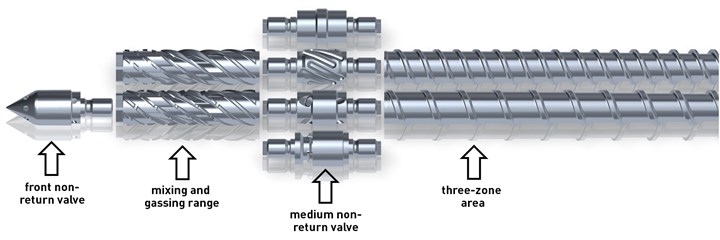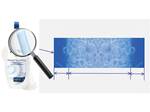Modular Screw Optimized for Microcellular Foam Molding
KraussMaffei says its HPS-Physical Foaming screw features a universal design and 30% higher plasticizing capacity for MuCell molding.
KraussMaffei (KM) developed a modular screw concept to analyze efficiency running different materials with MuCell microcellular foaming technology from Trexel. Ultimately, the company created a screw featuring bolt-on components allowing customization, with a design and engineering focus on the mixing and gas supply area; the center backflow barrier; and the three-zone area. As a result, KM says the HPS-Physical Foaming universal screw for MuCell provides 30% more plasticizing capability than standard screws and can be applied universally for low- and high-viscosity resins.
After testing various screw types available on the market in its lab, KM settled on a modular design that made it possible to combine the individual components by means of bolting.
The company was able to enlarge the three-zone area without impacting quality for a screw that is now 17 times the diameter of its predecessor. Previously 15D; mixing and gas supply area now come in with a 4D ratio. This geometry both increased the plasticizing performance and had a favorable effect on wear, according to KM. The company points out that normally larger and more expensive screws were applied to ensure complete homogenization of the melt before injecting the gas.
The middle non-return valve (M-RSP) closes at the end of the metering process, thereby separating the mixing and gas supply area from the three-zone section and preventing the melt from flowing back. This keeps the critical pressure above 33.9 bar, preventing foaming in the plasticizing unit. Another task of the M-RSP is to ensure a constant shot weight. The developers’ analyses showed that the most effective design of the M-RSP has a ball check valve. Here, too, the various materials used played a major role.
KM ran trials with existing screws and its newly developed model using PP with different melt flow indices — 11 and 44 — and various levels of mineral filling, including 20 and 30% long glass fiber, in addition to 30% filled ABS and PA6. The three-zone section was designed with one thread, although KM notes that for 30% glass-filled PA6 two threads would be even better. As for the M-RSP with ball check, a helical shear section is also possible for high-viscosity materials.
KM says the research that went into developing the HPS-Physical Foaming screw kit can now be extended to other applications and specialty screw designs for specific resins. For customers with long-running products, the modular screw concept is helpful for quick tests to see if process optimization is possible.

The HPS Physical Foaming Screw features a mixing and gas supply area; the center backflow barrier; and the three-zone area.
Photo Credit: KraussMaffei
Related Content
-
Improve The Cooling Performance Of Your Molds
Need to figure out your mold-cooling energy requirements for the various polymers you run? What about sizing cooling circuits so they provide adequate cooling capacity? Learn the tricks of the trade here.
-
How to Reduce Sinks in Injection Molding
Modifications to the common core pin can be a simple solution, but don’t expect all resins to behave the same. Gas assist is also worth a try.
-
Understanding the ‘Science’ of Color
And as with all sciences, there are fundamentals that must be considered to do color right. Here’s a helpful start.











.png;maxWidth=300;quality=90)



